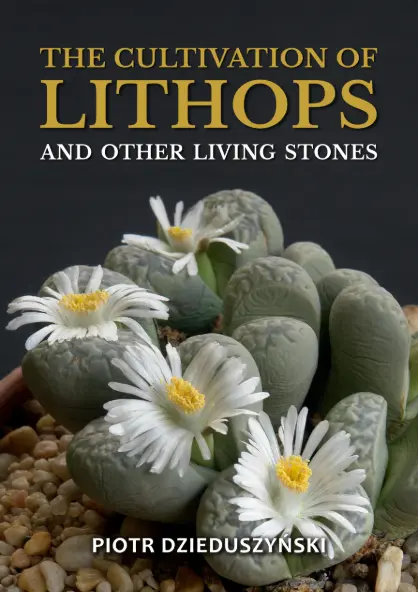EBOOK The Cultivation of Lithops and Other Living Stones
The Cultivation of Lithops and Other Living Stones by Piotr Dzieduszyński is an exciting new book on plants that are able to accumulate water during the dry season. These African succulents bear a striking likeness to the stones among which they grow, which is why they are called flowering stones or living stones. The resemblance of living organisms to their environment for protection purposes is a phenomenon known as mimicry. According to the current taxonomic classification, these plants belong to the family Aizoaceae, but they have become commonly known as mesembs.
This publication is intended for both, beginner plant lovers and intermediate-level readers who already have some experience, e.g. in cactus care. Once they have read this book, they will definitely succeed in cultivating these plants, whether on a windowsill or in a greenhouse.
In addition to discussing the most popular representatives of this family – lithops and conophyta – this publication also focuses on other mesembs. These include Aloinopsis, Argyroderma, Dinteranthus, Faucaria, Fenestraria, Gibbaeum, Glottiphyllum, Lapidaria, Pleiospilos, Rhombophyllum, Tanquana, Titanopsis.
The book consists of three parts:
Part I. The characteristics of living stones contains a botanical description of the family, as well as information on the distribution and conditions of natural occurrence of these plants.
Part II. The principles of mesemb cultivation is composed of guidelines on choosing a location for the collection, maintaining an optimal temperature, appropriate watering, and proper replanting, among others. A separate section is devoted to identifying and fighting pests and diseases. Much space is devoted to plant propagation using one of two methods, sowing seeds or growing seedlings. The cultivation tips can also be applied to plants that still live in the rhythm of the southern hemisphere, despite being grown in Europe or the United States. A cultivation calendar for lithops and other mesembs, which contains detailed care tips for each month of the year, concludes the second part.
Part III. An overview of selected mesembs genera is made up of short descriptions of the Aizoaceae family representatives and the principles of their cultivation. It also illustrates lithops cultivars and aberrations. The final section talks about the most common mesemb cultivation facts and myths.
The book is filled with high-quality photographs of these plants found in both, a collection, taken by Mirosław Dzieduszyński, and nature, taken by Jaromír Chvastek.
Piotr Dzieduszyński (born in 1972) – Doctor of Psychology, cacti and succulent lover. He has over 35 years of experience in living stone cultivation. His collection of mesembs is one of the largest in Poland. A long time member of the Polish Cactus Lovers Society (PTMK) and the Mesemb Study Group. He has organized a number of African succulent exhibits, as well as written numerous articles and given many lectures in order to spread the knowledge of these plants. For his efforts, he was awarded the PTMK Gold Badge in 2023.
TABLE OF CONTENTS
From the author
Part I
The characteristics of living stones
- What are living stones
- Where and in what conditions do living stones grow
- Distribution
- Climate
- Soils
- How are mesembs built
- How have mesembs adapted to harsh living conditions
- A specific way of growth
Part II
The principles of mesemb cultivation 24
- Lithops – the most popular representative of the mesemb family
- How to succeed in the cultivation of lithops and other mesembs living in the rhythm of the northern hemisphere
- Collection location
- Windowsill cultivation
- Maintaining an optimal temperature
- Outdoor cultivation
- Mini-greenhouse cultivation
- Greenhouse mesemb cultivation
- Coverless mesemb cultivation
- Detailed care rules
- Flowerpots
- Substrates
- Replanting
- Watering
- Fertilization
- Mesemb propagation
- Generative propagation
- Sowing substrate preparation
- Sowing containers
- Propagator
- Sowing method
- Seedling care
- Vegetative propagation
- How to fight pests and prevent diseases
- Pests
- Mesemb diseases
- Conophytum – a genus living in the rhythm of the southern hemisphere
- Where and in what conditions do conophyta grow
- Climatic conditions
- Anatomy
- Care
- Propagation
- Cultivation calendar for lithops and other mesembs
Part III
An overview of selected mesemb genera
- Genus Aloinopsis
- Genus Argyroderma
- Genus Dinteranthus
- Genus Faucaria
- Genus Fenestraria
- Genus Gibbaeum
- Genus Glottiphyllum
- Genus Lapidaria
- Genus Pleiospilos
- Genus Rhombophyllum
- Genus Tanquana
- Genus Titanopsis
Lithops cultivars and aberrations
Instead of an afterword. Mesemb cultivation facts and myths
References
96,00 zł
Out of stock
Additional information
| Autor | Piotr Dzieduszyński |
|---|---|
| Year of issue | 2024 |
| Pages | 138 |
| Type of publication | Ebook |
| File format | EPUB, PDF, MOBI |









Reviews
There are no reviews yet.